 |
|||||
|
|||||
| Preview of Stamps Catalogue: VOLUME 1 |
 |
|||||
|
|||||
| Preview of Stamps Catalogue: VOLUME 1 |
Note: on my website many of the
pictures can not be seen! They are of course present in the catalogue;
contact me if you want to purchase it.
Placido Ramon de Torres was born in 1850 in Spain (source: http://www.philahistorica.de/Dokumente/MonacoPhilKatDt.pdf)
Placido Ramon de Torres issued the first Italian stamp catalogue in 1873 when he was in Livorno (Leghorn, via Maggi No2). This was merely a pricelist, with only a few images on the frontpage (it can be downloaded with Google books). The title of this catalogue was: "Catalogo descrittivo di tutti i franco-bolli emessi dal 1840 al 1873 colle date di emissione, lor valore e particolarita in vendita.", 52 pages, P.R.De Torres. It is listed in the Bibliografia Italiana under the "Catalogo Alfabetico delle Pubblicazioni Italiane" of 31 Maggio 1873. During this time he also published a magazin "La Posta Mondiale", which ceased to exist after 12 issues. According to Gerhard Lang he was also involved in preparing essays of Italian local revenue stamps for various cities.
Placido Ramon de Torres issued the "Album Illustrado para Sellos de Correo" in 1879 (information passed to me thanks to Gerhard Lang, 2016). This catalogue has illustrations of some of the stamps. Here are some examples of the images from this catalogue that correspond to forgeries. Either these forgeries were inspired by the de Torres catalogue, or de Torres copied images of forgeries into his catalogue. In many instances, the same images also appear in "The illustrated catalogue of postage stamps" by J.E.Gray of 1870. It is possible that most (if not all) of these images were used to produce forgeries.
According to the book 'Philatelic forgers, their lives and
works', de Torres lived in Malaga in 1886, when he was arrested
on a sales trip to Bremen (Germany) but managed to escape.
Afterwards, in 1892, he went under the alias of Rosendo Fernandez
on another sales trip to Cuba, Mexico and the United States.
Again he was arrested for selling forgeries.
When he came back to Spain, he took part in the 1893 Melilla
bogus stamp issue.



Genuine 3 Sch stamp of Bergedorf (first iamge) A forgery with the
'3's much too thin. A similar image appears in the catalogue of
de Torres of 1879 on page 33 (third image)

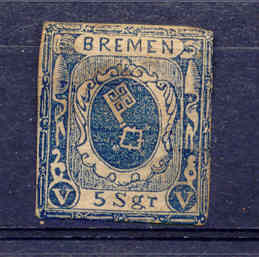


Two genuine stamps and a forgery in wrong colour blue instead of
green. The design of this forgery is identical to the image given
in "The illustrated catalogue of postage stamps" by
J.E.Gray (1870, page 11, see third image). A similar image
appears in the catalogue of de Torres of 1879 on page 28 (fourth
image).

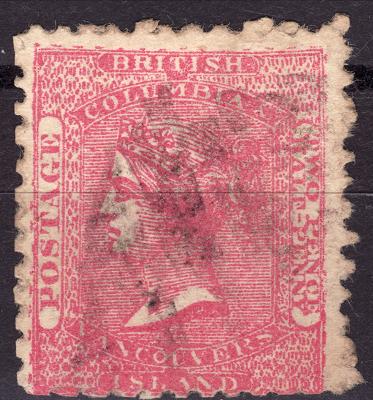


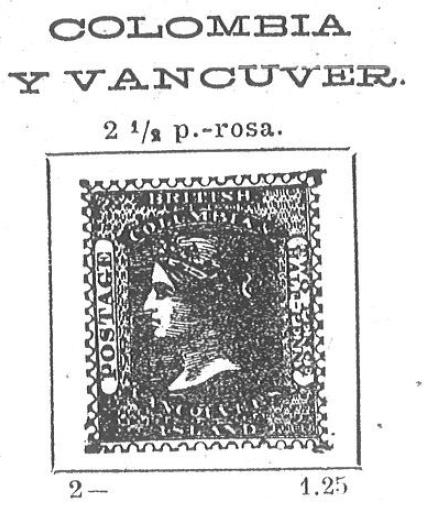
Rather blur forgery of British Columbia and Vancouver Island with
wrong perforation (11 1/2 instead of 14). It even exists in the
color blue (with printed perforation). The design is similr to
one given in "The illustrated catalogue of postage
stamps" by J.E.Gray (1870, page 105). A similar image
appears in the catalogue of de Torres' album of 1879 on page 183.
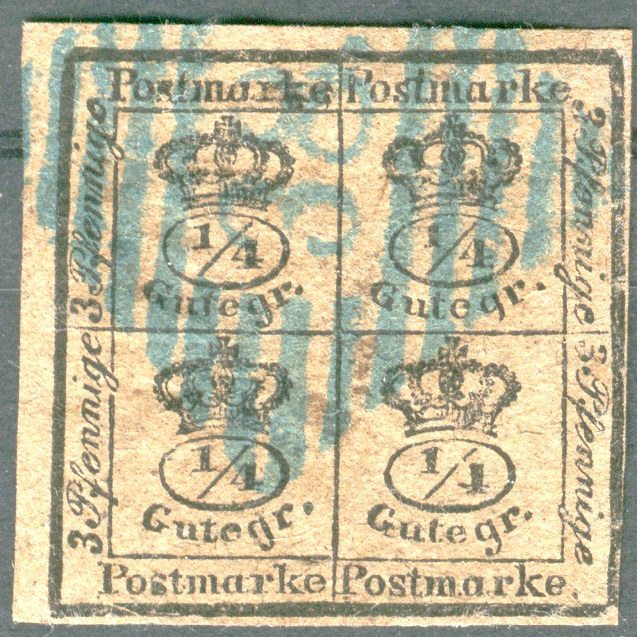



Genuine 1857 stamp of Brunswick (first image). Next to it a
forgery which I have been told was made by the forger Young. Note
the very large space between "Gute" and "gr".
The design of this forgery is identical to the image given in
"The illustrated catalogue of postage stamps" by
J.E.Gray (1870, page 13, see second image).A similar image
appears in the catalogue of de Torres of 1879, page 34.





Confederate States 1 c. The first image shows a cut from a Scott
album of 1886, second and third forgeries based on this cut. The
face is very strange and the "O" of "ONE" is
placed too low. Actually, this 'forgery-image' already appeared
earlier in "The illustrated catalogue of postage
stamps" by J.E.Gray of 1870 on page 115 (fourth iamge). It
also appeared in the catalogue of Placido
Ramon de Torres "Album Illustrado para Sellos de
Correo" of 1879 (information passed to me thanks to Gerhard
Lang, 2016) on page 184 (fifth image).
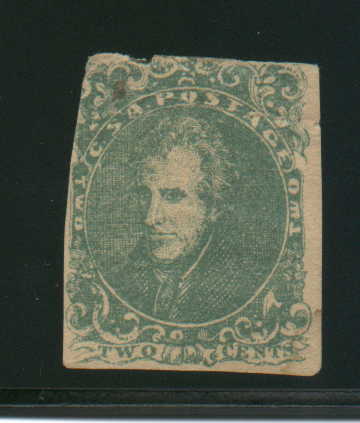
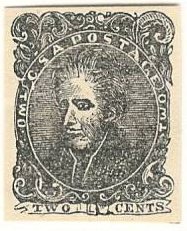
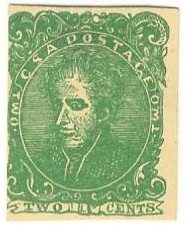
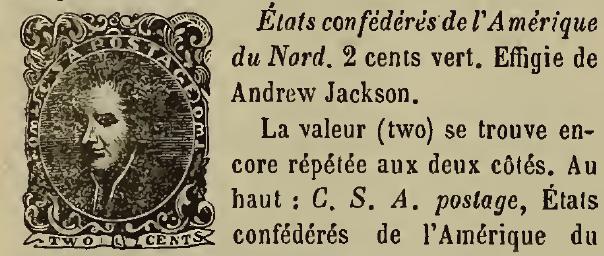
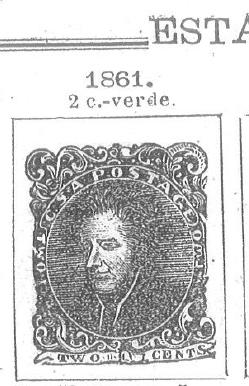
Confederate States 2 c. First image shows a genuine stamp. The
second image shows a cut from a Scott album
of 1888, the third image shows a forgery based on this cut.
Actually, this 'forgery-image' Actually, very similar
'forgery-images' already appeared earlier in Le Timbre Poste of
February 1864 of Moens (page 10, or
fourth image above) and in the catalogue of Placido Ramon de
Torres "Album Illustrado para Sellos de Correo" of 1879
(information passed to me thanks to Gerhard Lang, 2016) on page
184 (fifth image). The Moens and de Torres images are slightly
different (see for example the arching in the upper right
ornament).



Genuine 1 p stamp of Dominica (first image) Primitive forgery
(second image). Note the white patches in the hair. The design of
this forgery appears to be similar to an image that appears in
the catalogue of Placido Ramon de Torres of 1879 on page 163
(third image).




Genuine (first image) and forgery of the 5 F Napoleon stamp of
France (second image; obtained thanks to Mark Toft). Next to it
an image of the "The illustrated catalogue of postage
stamps" by J.E.Gray (1870, page 199, see third image). This
forgery can also be found in the catalogue of Placido Ramon de
Torres on page 63 (fourth image). The "5" and the
"F" interrupt the horizontal lines with a white
interior. Also note the weird shape of the letters "A"
and "S" in the word "FRANCAIS" and other
badly printed letters. There is also an extra horizontal
line in the bottom left corner. In the de Torres image, there are
some lines and smudges under the head that do not appear in any
of the other images.




Postage due forgeries of France. The design is similr to one
given in "The illustrated catalogue of postage stamps"
by J.E.Gray (1870, page 18). Also an illustration of the same
forgery that appeared on page 65 of de Torres' album.




Genuine 4 p stamp first issue of Gambia and a very primitive
forgery with the head of the Queen drawn instead of embossed. The
design of this forgery is identical to the image given in
"The illustrated catalogue of postage stamps" by
J.E.Gray (1870, page 206, third image). This forgery can also be
found in the catalogue of Placido Ramon de Torres on page 149
(fourth image). Note that in the forgery and both catalogue
illustrations, the upper left hand side is missing.
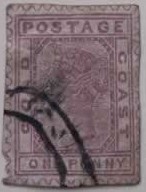
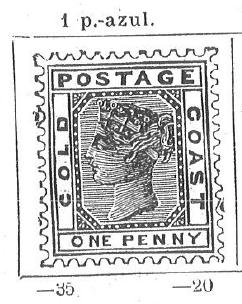
Very primitive forgery of Gold Coast with printed perforations.
It is very likely based on or made with the printing plates that
can also be found in an illustration in the catalogue of Torres
"Album Illustrado para Sellos de Correo" of 1879
(information passed to me thanks to Gerhard Lang, 2016). The Gold
Coast stamp appears on page 153 of this catalogue.
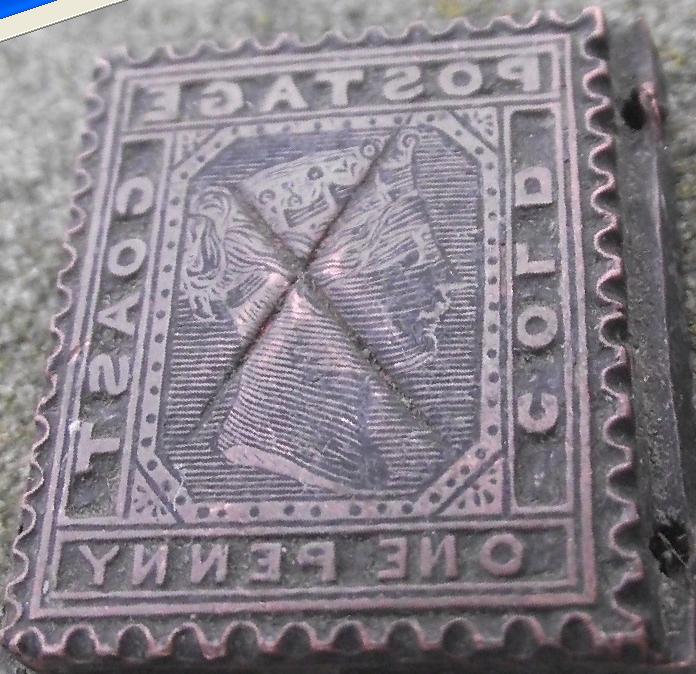
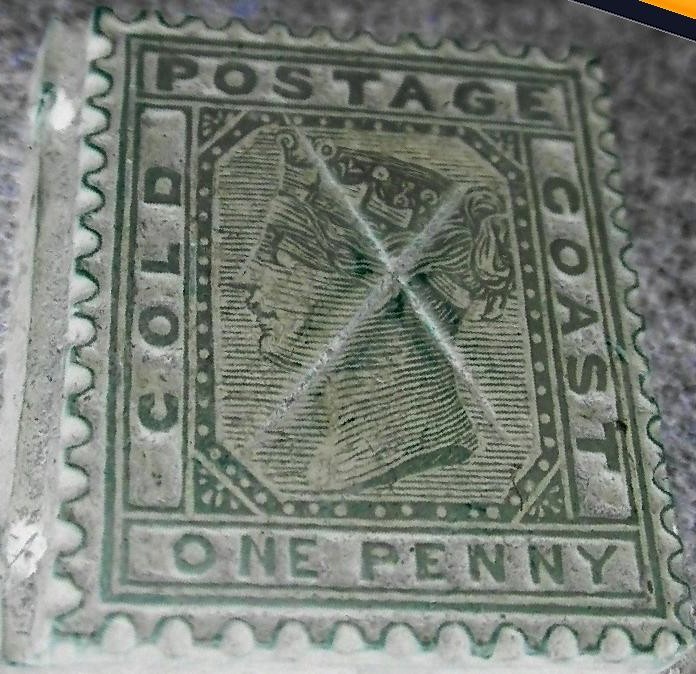
Here the actual (defaced) printing plate of this forgery. Left as
it appears. Right mirror image as it would have been printed.



Hawaii 18 c genuine stamp (first image) Forgery (second image),
note the different '8's in the upper circles. A similar image
appears in the the catalogue of de Torres "Album Illustrado
para Sellos de Correo" of 1879 (third image).





Newfoundland 3 p first issue. Genuine stamp (first image).
Forgery (second image). Primitive forgery with perforation (third
image). The design of this forgery is identical to the image
given in "The illustrated catalogue of postage stamps"
by J.E.Gray (1870, page 126, fourth image). A similar image
appears in the catalogue of Placido Ramon de Torres of 1879 on
page 226 (fifth image above). It looks like both forgeries were
based on the Gray/de Torres design.
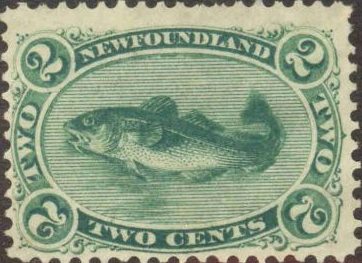
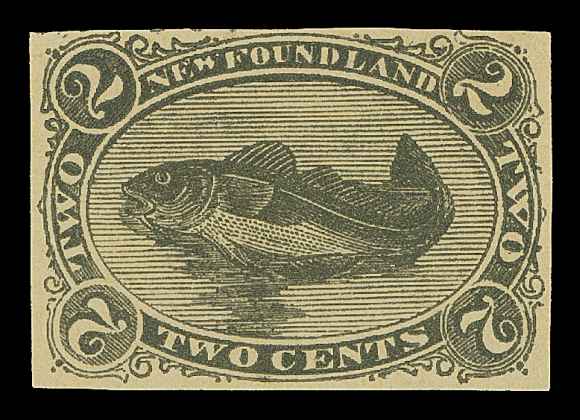
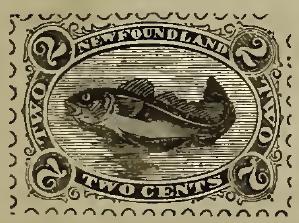
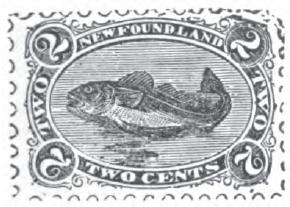
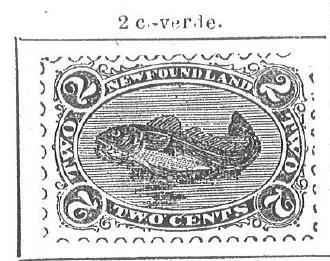
Newfoundland codfish design; genuine stamp (first image). Is the
second image a Moens forgery? Moens, or someone taking the Moens
design, seems to have made a forgery of this stamp (1866 issue),
it can easily be recognized, because it is black instead of
green. Furthermore the numerals are larger than in the genuine
stamp. The third image shows an image from Le Timbre Poste by
Moens No.38, February 1866, page 9. The design of this forgery is
identical to the image given in "The illustrated catalogue
of postage stamps" by J.E.Gray (1870, page 127, fourth
image). A similar image appears in the catalogue of Placido Ramon
de Torres of 1879 on page 227 (last image above).




Genuine New South Wales 2 p blue of the first issue. The second
image shows a mystery item 2 p in color red, which is presumably
a forgery. The design of this forgery is identical to the image
given in "The illustrated catalogue of postage stamps"
by J.E.Gray (1870, page 160, see third image). This forgery can
also be found in the catalogue of Placido Ramon de Torres of 1879
on page 243 (fourth image). It appears that de Torres copied the
image from Gray, since the 'cut and paste' lines can still be
seen. The other three images were probably made by de Torres
himself (since the Gray catalogue does not have these images).





Reunion 15 c of the first issue; first image genuine stamp,
second and third image: forgeries. Outer framelines too far apart
from each other and "R" of "Reunion" touches
the circle below it. The design of this forgery is identical to
the image given in "The illustrated catalogue of postage
stamps" by J.E.Gray (1870, page 94, see fourth image above).
A similar image appears in the the catalogue of de Torres of 1879
(page 242, fifth image above).
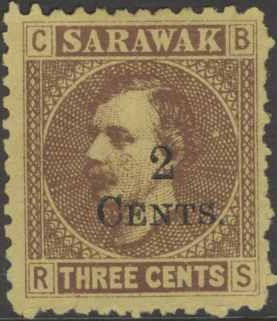
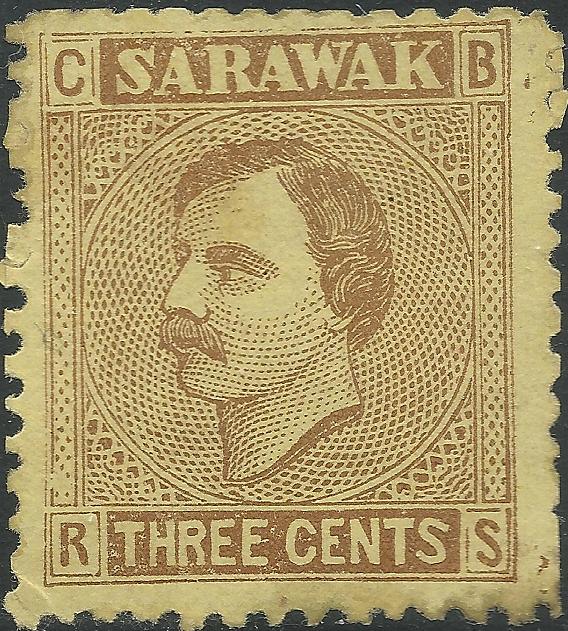
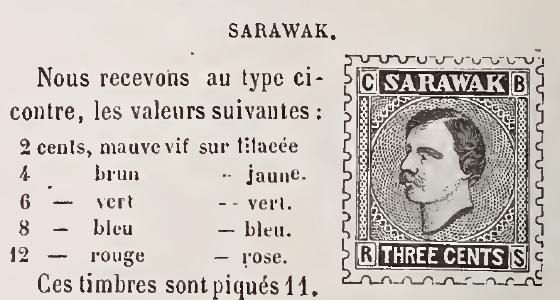
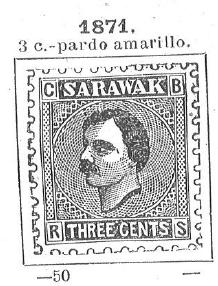
Genuine stamp of Sarawak and forgery, the lettering is different
(for example the bottom right "S") and the face of
Brooke as well. The third image shows an image of Le Timbre Poste
by Moens of No 145 January 1875 on which the forgery was
apparently based. This forgery can also be found in the catalogue
of de Torres (page 157 under Africa, while is should be Asia!).
So presumably this forgery was inspired by the Moens catalogue,
and then copied by de Torres. Further proof of this is the fact
that the 'perforation' design is cut off at the top and bottom by
de Torres.










St.Christopher genuine 6 p stamp (first image). All the next
stamps are forgeries, the Queen has a very hooked nose and looks
very 'sour'. Also the inscription in the 3 p reads 'Three Pence'
instead of "THREEPENCE". Note that the word "SIX
PENCE" in the green and brown forgery are written much
larger than in the orange ones. A similar image appears in the
catalogue of Placido Ramon de Torres of 1879 on page 211.






St.Lucia first issue, genuine stamp (first image). All other
stamps show a set of primitive forgeries with very thick
lettering; note for example the right hand side of the
"A" of "POSTAGE". There is also a break in
the outer shape of the ellipse just before the 'P' of 'POSTAGE'.
The last one with "2 1/2 PENCE" does not have this
break, which might indicate that the other forgeries were made
after the overprint was erased. A similar image appears in the
catalogue of de Torres of 1879 on page 218. The de Torres stamp
does not have the break in front of the "P".



Two 'SW' forgeries from Victoria (1853). These corner letters do
not appear in a genuine stamp in this combination. Two slightly
different types, made by the same forger? A similar image appears
in the catalogue of de Torres on page 249.

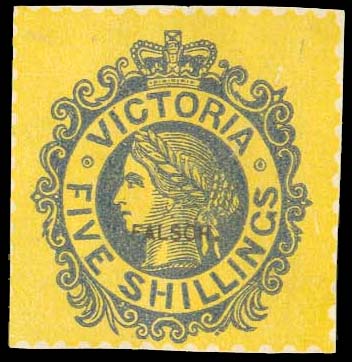



Victoria genuine 5 Sh stamp of 1868 and a Senf
forgery with printed perforation. I have seen it with the
perforation 'cut out' and the word "FALSCH" overprinted
with a manual cancel (see:
http://stampsofvictoria.com/laureates.php). The curly design at
the bottom of the stamp is inverted. Also the ornament at 10
o'clock is missing. This image appears to have been copied from
an illustration in the magazine Le Timbre Poste by Moens, No.68, page 58, August 1868 (the
same image also appears in the same journal in Nr.63, March 1868,
page 19).. The design of this forgery is identical to the image
given in "The illustrated catalogue of postage stamps"
by J.E.Gray (1870, page 174, see fourth image). A similar image
appears in the catalogue of Placido Ramon de Torres of 1879 on
page 251 (last image).
Stamps - Timbres-Poste - Briefmarken